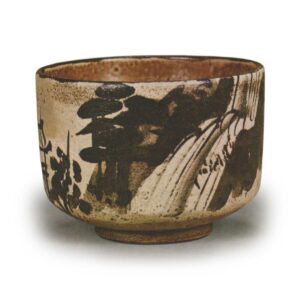



Transmitted to the Fukui family of Komatsubara, Kyoto
Dimensions
Height: 7.6 cm, Mouth diameter: 10.3 cm, Foot diameter: 5.1 cm, Height of foot: 0.7 cm, Weight: 232 g
This is one of Kenzan’s representative works, inheriting the techniques of Ninshō and greatly influenced by Korin.
Kenzan perfected Ninshō’s techniques and made efforts to break away from them and return to the Oribe style. However, he could not achieve the strength inherent in Oribe. Ultimately, he drifted toward a literati-style aesthetic.
This is an important point to note when viewing Kenzan’s work.
The practice of inscribing poetic verses on tea bowls in a literati style began with Kenzan.
Thus, Kenzan marks the transition to the so-called literati-style sencha tea ceremony, and it is at this point that “Mokume” emerges. Of course, the Zen Buddhism of the Obaku school played a significant role in supporting this trend.
The designs on these tea bowls include waterfalls and landscapes, as well as plum blossoms, camellias, and hydrangeas, often accompanied by poetry, creating a harmonious blend of poetry and painting. The compositions and brushwork are bold and distinctive, characteristic of his style.



